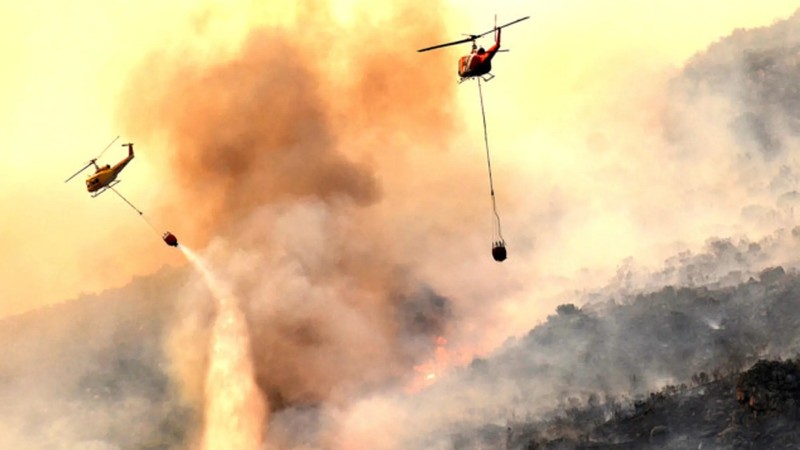A Warning of More to Come?
As dawn broke over the Western Cape, the charred slopes of Du Toit’s Kloof Pass stood as a stark reminder of yet another wildfire season in the region. Firefighting crews, battling through the night against fierce winds, finally managed to contain the flames. Though the immediate danger has passed, the fire’s rapid spread highlights a growing concern—are wildfires becoming an unstoppable force in the Cape?
A Growing Crisis
Wildfires are nothing new to the Western Cape, but their intensity and frequency have increased dramatically over the years. From the devastating 2017 Knysna fires to the 2021 Table Mountain blaze, fire seasons are lasting longer, spreading faster, and burning hotter. Experts warn that climate change is a key factor. Rising temperatures, prolonged droughts, and erratic wind patterns are creating the perfect conditions for fires to ignite and rage out of control.
According to environmental studies, South Africa’s average temperature has risen by more than 1°C over the past century, with the Western Cape seeing even sharper increases. This warming trend means that vegetation dries out more quickly, turning landscapes into fire-prone tinderboxes.
The Silent Fuel: Alien Vegetation
While weather conditions play a major role, another dangerous factor is hiding in plain sight—alien vegetation. Invasive species such as pine, wattle, and eucalyptus trees spread rapidly and burn at much higher temperatures than indigenous plants. Unlike the Cape’s fynbos, which has evolved to withstand natural fires, these foreign trees fuel blazes that are more destructive and harder to control.
CapeNature and conservation groups have long warned about the dangers of alien vegetation. Efforts to remove these species have been ongoing, but the cost and scale of the problem make it difficult to manage. Until large-scale clearing operations are prioritized, these “green ticking time bombs” will continue to intensify wildfires across the province.
Firefighters on the Frontline
The battle against the Du Toit’s Kloof fire was not an easy one. Strong winds fuelled the flames, pushing them across ridges and making containment efforts risky. Ground crews from CapeNature, NCC Wildfires, and Lewis Bush Clearing worked tirelessly through the night, using back burns and hand tools to stop the fire’s spread. A flare-up in the early hours of the morning threatened to reignite the blaze, but it was quickly managed.
Despite their success, firefighters know that this is only the beginning. With peak fire season still ahead, resources are stretched thin, and crews are preparing for the next inevitable call.
What Can Be Done?
As wildfires become a bigger threat, the question remains—what can be done to prevent disasters like this? Experts suggest that a combination of solutions is needed:
Clearing alien vegetation: More funding and resources should be allocated to removing high-risk trees and plants.
Stronger firebreaks: Landowners and authorities must enforce proper firebreaks in high-risk areas.
Community awareness: Education campaigns can help reduce human-caused fires, which remain a major contributor to wildfire outbreaks.
Improved firefighting resources: More investment in equipment, personnel, and aerial firefighting capabilities could make a significant difference in controlling fires before they spread.
A Glimpse into the Future?
The Du Toit’s Kloof fire is now under control, but it leaves behind an unsettling question—are we prepared for what’s coming? As climate change accelerates and alien vegetation continues to spread, wildfires in the Western Cape may only grow more intense. If action isn’t taken soon, the next fire could be far more devastating.
Public Concerns Over Fire Season
The recent fire in Du Toit’s Kloof Pass has heightened public anxiety about the increasing frequency and severity of wildfires in the Western Cape. Residents are expressing concerns about the potential for future fires to cause more significant damage if proactive measures aren’t taken. The Cape Wine lands District Municipality has urged motorists to exercise caution in affected areas, emphasizing the importance of public cooperation during such events. www.news365.co.za
Government Response and Public Sentiment
In response to the escalating wildfire threat, the Western Cape government has allocated R16 million for the current wildfire season. Provincial Minister of Local Government, Anton Bredell, highlighted that a staggering 97% of wildfires are human-induced, either accidentally or intentionally. This statistic has sparked public discourse on the need for increased awareness and preventive measures within communities. www.sabcnews.com
Community Impact and Calls for Action
The cumulative effect of recent fires has led to the displacement of over 250 individuals and the destruction of thousands of hectares across multiple municipalities in the Western Cape. Communities are calling for more robust firefighting resources and better land management practices to mitigate the impact of future wildfires. www.capeindependent.com
These reactions underscore the urgency for comprehensive strategies that involve government action, community engagement, and individual responsibility to address the growing wildfire threat in the region.

